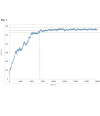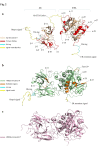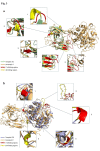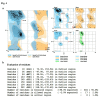Simulation and Stability Assessment of Anti-EpCAM Immunotoxin for Cancer Therapy
- PMID: 30276141
- PMCID: PMC6156485
- DOI: 10.15171/apb.2018.052
Simulation and Stability Assessment of Anti-EpCAM Immunotoxin for Cancer Therapy
Abstract
Purpose: Epithelial cell adhesion molecule (EpCAM) is a dominant antigen in human colon carcinoma tissue. Topology features of this antigen are different in normal and malignant conditions; for instance, EpCAM is much less accessible to antibodies in normal cells than in cancerous tissues. Hence, EpCAM has been considered as a suitable candidate for cancer target therapy via immunotoxins (ITs) development. In this study, attention was focused on the stability assessment of anti-EpCAM-IT (anti-Ep-IT) to design a novel IT. Methods: The 3D structures of the antibody template and the toxin segment of anti-Ep-IT were retrieved from PDB. Discovery Studio3.0 was used to separate the ligands and water molecules. The antibody (Ab) fragment of anti-Ep-IT was aligned using protein blast (BLAST-p), and SWISS-MODEL database was used for Ab modeling. IT modeling was accomplished using MODELLER 9.15. Also, GROMACS 5.07 was used for molecular dynamic (MD) simulation step. Moreover, ERRAT and RAMPAGE databases were used for quality assessment of the structures. Results: BLAST-p results indicated that antibody moiety of IT has the highest E-value and query coverage scores to the monoclonal antibody (mAb) 4D5MOC-B. Modeling by SWISS-MODEL provided a reasonable template for Ab portion compared to MODELLER. The best modeled full-length IT with the lowest RMSD values was selected. Finally, RMSD plot for MD stage demonstrated constant values from 7000ps to 20000ps. Conclusion: In general, both modeling results and their quality evaluations were satisfactory for designing IT. Moreover, RMSD plot revealed that IT stability was preserved during the simulation. Overall, our findings led to modeling and simulation of the anti-Ep-IT with more structural stability.
Keywords: Cancer therapy; EpCAM; Immunotoxin; Simulation; Stability.
Similar articles
-
Construction, expression, and characterization of a recombinant immunotoxin targeting EpCAM.Mediators Inflamm. 2015;2015:460264. doi: 10.1155/2015/460264. Epub 2015 Apr 16. Mediators Inflamm. 2015. PMID: 25960617 Free PMC article.
-
Antibody Based EpCAM Targeted Therapy of Cancer, Review and Update.Curr Cancer Drug Targets. 2018;18(9):857-868. doi: 10.2174/1568009618666180102102311. Curr Cancer Drug Targets. 2018. PMID: 29295696 Review.
-
Increasing anticarcinoma activity of an anti-erbB2 recombinant immunotoxin by the addition of an anti-EpCAM sFv.Clin Cancer Res. 2007 May 15;13(10):3058-67. doi: 10.1158/1078-0432.CCR-06-2454. Clin Cancer Res. 2007. PMID: 17505009
-
An anti-EpCAM antibody EpAb2-6 for the treatment of colon cancer.Oncotarget. 2015 Sep 22;6(28):24947-68. doi: 10.18632/oncotarget.4453. Oncotarget. 2015. PMID: 26317650 Free PMC article.
-
Epithelial cell adhesion molecule expression (CD326) in cancer: a short review.Cancer Treat Rev. 2012 Feb;38(1):68-75. doi: 10.1016/j.ctrv.2011.04.002. Epub 2011 May 14. Cancer Treat Rev. 2012. PMID: 21576002 Review.
Cited by
-
Evolution of Thyroglobulin Loop Kinetics in EpCAM.Life (Basel). 2021 Sep 3;11(9):915. doi: 10.3390/life11090915. Life (Basel). 2021. PMID: 34575064 Free PMC article.
References
-
- Oladi F, Yossefi E, Momeni-Moghaddam M. The role of EpCAM in cancer progression. Journal of Cellular Immunotherapy. 2017;3(1):10. doi: 10.1016/j.jocit.2017.04.014. - DOI
LinkOut - more resources
Full Text Sources
Research Materials
Miscellaneous




